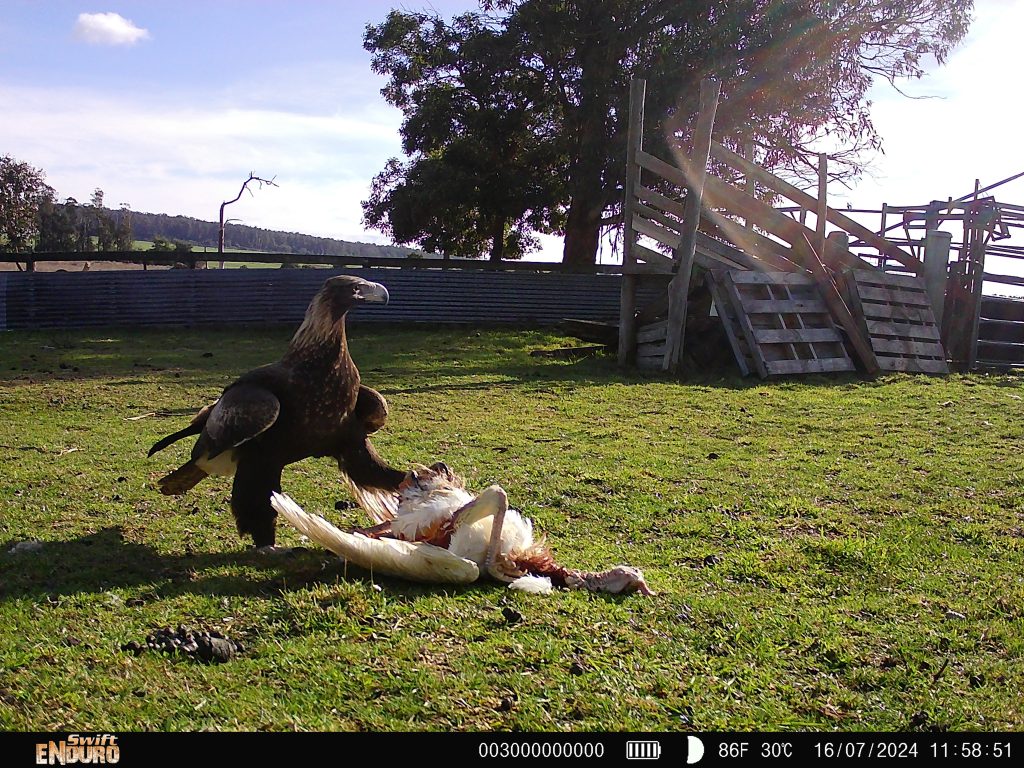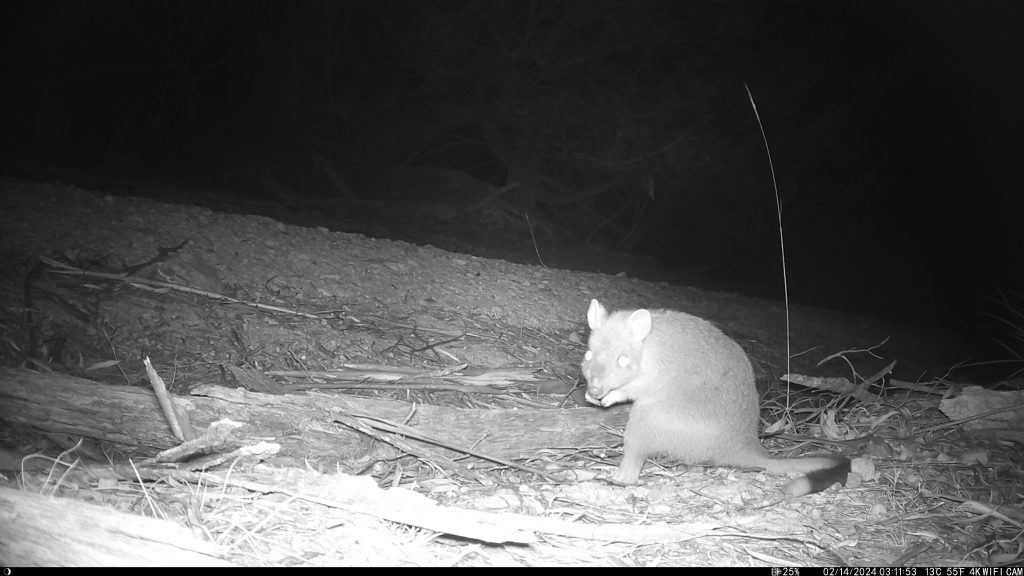Quollage
A neighbour mentioned seeing cats going beneath the building, so I set up a camera to investigate. As expected, the neighbour’s cats were indeed visiting, but I was also surprised to discover that some quolls have made my cottage their home. In the videos, you can see the quoll carrying denning material into the cavity, grooming itself, scent marking, and generally being adorable.
Andrew Campbell
Spotted-tailed quoll (Dasyurus maculatus)
In the Tassie Midlands, a breeding female quoll requires between 400 and 1,000 hectares of woodland habitat, depending on local rainfall. Females are territorial but may be willing to share their home range with their daughters early in life, while males have larger, overlapping home ranges. Despite their preference for woodlands, spotted-tailed quolls can traverse long distances across open paddocks and developed areas, provided there is sufficient cover like tall grass along fencelines, rocks, and wood piles. One quoll was tracked running across a 10 km stretch of pasture between woodland patches. Like many Australian animals, habitat clearance, modification, and fragmentation pose the primary threats to spotted-tailed quolls. The removal of dead wood and other discrete habitat elements, significantly restricts den resources available to quolls. Competition with cats for food, road collisions, and direct or accidental poisoning further contribute to the challenges quolls face.
Cray-z climb
We’re lucky to have the endangered Giant Freshwater Crayfish living in our creek. Being cold blooded, they don’t trigger cameras but one set to one minute timelapse caught this one making its way up and over the rocks.
Larena woodmore
Giant freshwater crayfish (Astacopsis gouldi)
The GFC is the world’s largest freshwater crustacean and a true icon of Tasmania. Historically, some crays grew up to 6kg and lived for up to 35 years. Today, due to past fishing pressures (now illegal), they are much smaller, weighing between 2-3kg. GFCs thrive in cool (<18°C), well-oxygenated rivers and streams flowing into the Bass Strait, as well as in the Arthur River Catchment. Young crays rely on hiding spots beneath cobbles, boulders, logs, or dense vegetation to evade predators, while adults can dig their own shelters in stream banks or beds. They feed primarily on leaf litter, fallen wood and aquatic plants but will also eat small invertebrates. GFCs face an uphill battle. Their main threats include increasing frequency of drought and floods, water pollution, ongoing habitat disturbance, and poaching. One of the best ways that we can protect this species is by retaining and restoring native vegetation in riparian zones.

Gobbling a gobbler
This free-range turkey became a delight for the Wedgies. The photo was taken at our Land for Wildlife property, an oasis for wildlife amidst surrounding intensively managed farms. This year we’ve been fortunate to regularly sight a group of four eagles on our farm.
Sally Bond
Wedge-tailed eagle (Aquila audax fleayi)
Birds of prey were once regular targets of hunters and farmers. Wedge-tailed eagles, the largest raptors in Australia and among the largest in the world, were persecuted for their reputation as lamb killers. One article from the Mercury in 1923 describes an elaborate method that farmers used to capture eagles. A “stockade of logs” would be “constructed round the carcase of a sheep or lamb to a height of about three or four feet, with a similar measurement in length and width. The eagle, upon either seeing or smelling the sheep, naturally alights on the logs, and hops down inside the enclosure” but the eagle being “unable to rise abruptly from the ground, is a prisoner until the shepherd on his round comes across him”. The Tasmanian subspecies of wedge-tailed eagle is now listed as Endangered. These eagles are more sensitive to breeding disturbances from human activities compared to their mainland counterparts. They lay fewer eggs and fledge fewer chicks, with around 60% of all nesting attempts failing in Tasmania.

Smart survivor
Caught in an uncharacteristically static pose, the bettong pauses to sniff a tiny morsel it has dug from the forest floor. Most other pictures show them darting along the track, a blur in the darkness. Positioned in a covenant of white gum forest on my property, the camera reveals a number of potential predators: a resident devil, feral cats and the odd free-roaming dog. The bettong must be swift and ever-vigilant.
Heather Jones
Eastern bettong (Bettongia gaimardi)
Bettongs are quintessential ecosystem engineers. As they forage for food, these industrious creatures dig up large amounts of soil, which helps to improve soil condition, promote seedling growth, and maintain fungal communities. The holes they create serve as microhabitats for plants and invertebrates, and their activity has even been shown to have the potential to slow down bushfires! These habitat specialists are primarily found in open dry eucalypt forests and woodlands. About 80% of a Tasmanian bettong’s home range (~50-150ha) consists of woodland. Fungi, especially native truffles that grow underground on the roots of trees and shrubs are a primary food source for eastern bettongs. They also eat some fruits, seeds, and invertebrates. Despite their important ecological role, and the island being their last refuge, eastern bettongs remain unknown to many Tasmanians and they are the most commonly misidentified species on WildTracker.
Not blinded by the (infrared) light.
Last year, during the Tasmanian Devil Vaccine bait trials on my Conservation Covenant (TLC Revolving Fund) property, I set up my fauna camera to record video alongside the Menzies/UTAS research camera. While the research camera was set to take 10 still images per trigger, mine was set to record 10-second videos. My camera seemed particularly impressed, capturing an additional 18-second video! In that video, you can see the IR flashes, and a mother devil with a huge pouch, who was more interested in the camera than the bait. I am absolutely enamoured by this footage and its coincidental composition, capturing such a precious subject.
Nicole Anderson
Tasmanian devil (Sarcophilus harrisii)
The spread of the contagious cancer, devil facial tumour disease (DFTD), caused the Tasmanian Devil to be listed as Endangered in 2008. There are no treatment options for DFTD but there are significant research efforts into developing a vaccine. Passive infrared (PIR) camera traps detect the infrared radiation emitted by all objects that generate heat, including animals. Infrared radiation has wavelengths beyond the spectrum of visible light and so cannot be seen by humans and most animals. Cameras are triggered when the PIR sensor detects a temperature difference between a moving animal and its surrounds. Small animals and those at greater distances trigger cameras less often because less heat (i.e. infrared radiation) reaches the detector. Once activated, the camera casts its own infrared flash over the scene. In this scenario, the flash can be observed as it was recorded by another IR-sensitive camera. The result is an image that reveals a halo of invisible light above the devil captured in the middle.
